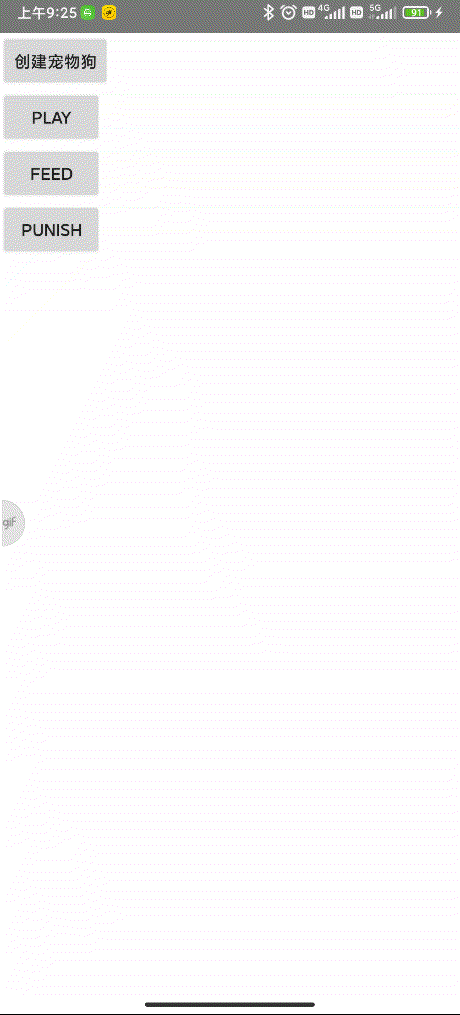本文主要是介绍【达内课程】面向对象之构造方法和重载,希望对大家解决编程问题提供一定的参考价值,需要的开发者们随着小编来一起学习吧!
文章目录
- 构造方法
- 举例说明构造方法
- 关键字 this
- 举例说明 this 关键字
- 方法重载 Overload
构造方法
概念了解
Java构造函数,也叫构造方法,是JAVA中一种特殊的函数。与函数名相同,无返回值。
作用:一般用来初始化成员属性和成员方法的,即 new 对象产生后,就调用了对象的属性和方法。
几点说明
1、构造方法是新建实例时执行的特殊方法
例如我们上一章新建 Soldier 类时也就调用一个构造方法
s1 = new Soldier();
2、一个类必须有构造方法,如果不写构造方法,编辑器编译代码时,会默认添加一个构造方法,如下:
public class A(){//添加的默认无参空方法,没有返回类型public A(){}
}
3、构造方法可以有多个,但参数不一样,称为构造方法的重载。这样增加了程序的灵活性
public class A(){public A(int i){...}public A(double d){...}public A(int i,double d){...}
}
如果类中有显示的构造方法,那么默认构造方法将无效。也就是创建实例时,就不能写new A();因为已经写了构造参数,运行时就不会再添加默认的构造方法。所以如果有显示的构造方法,还想保留默认构造 方法,需要显示的写出来。一个好的编程习惯是要保留默认的构造方法。(为了方便一些框架代码使用反射来创建对象)。
4、构造方法的作用,通常用来给成员变量赋值
给对象初始化数据可以使用构造方法或 setter 方法,通常情况下,两者都会保留
5、构造方法的名称必须与类名完全相同,构造方法不允许声明返回值
6、super(); 表示调用父类的构造方法,只有在子类的构造方法中,才能调用父类的构造方法。其中super(); 必须在有效代码的第一行,上边写注释是可以的,但不能放其他非注释代码
举例说明构造方法
首先我们创建一个宠物狗类,它的成员属性有 名字(name)、饥饿度(hungry)、快乐度(happy)。当我们喂食(feed)时,它的饥饿度降低。当我们陪它玩耍(play)时,饥饿度增高,快乐度增高。当我们惩罚(punish)它时快乐度降低。
Dog
public class Dog {public String name;//名字public int hungry;//饥饿度public int happy;//快乐度//喂食public void feed(TextView textView) {if (hungry == 0) {textView.setText(name + "吃饱了\n" + textView.getText());return;}hungry -= 10;textView.setText("给" + name + "喂食,hungry:" + hungry + "\n" + textView.getText());}//玩public void play(TextView textView) {if (hungry == 100) {textView.setText(name + "很饿了\n" + textView.getText());return;}happy += 10;hungry += 10;textView.setText("陪" + name + "玩耍,happy:" + happy + ",hungry:" + hungry + "\n" + textView.getText());}//惩罚public void punish(TextView textView) {happy -= 10;textView.setText("打" + name + "," + name + "哭叫:汪,happy:" + happy + "\n" + textView.getText());}
}
xml
<LinearLayout xmlns:android="http://schemas.android.com/apk/res/android"android:layout_width="match_parent"android:layout_height="match_parent"android:columnCount="4"android:orientation="vertical"android:rowCount="6"><Buttonandroid:id="@+id/button1"android:layout_width="wrap_content"android:layout_height="wrap_content"android:onClick="doClick"android:text="创建宠物狗" /><Buttonandroid:id="@+id/button2"android:layout_width="wrap_content"android:layout_height="wrap_content"android:onClick="doClick"android:text="play" /><Buttonandroid:id="@+id/button3"android:layout_width="wrap_content"android:layout_height="wrap_content"android:onClick="doClick"android:text="feed" /><Buttonandroid:id="@+id/button4"android:layout_width="wrap_content"android:layout_height="wrap_content"android:onClick="doClick"android:text="punish" /><TextViewandroid:id="@+id/textView"android:layout_width="match_parent"android:layout_height="wrap_content"android:textColor="#222222"android:textSize="18sp"/></LinearLayout>
MainActivity
public class MainActivity extends AppCompatActivity {Dog dog;Button create;Button play;Button feed;Button punish;TextView textView;@Overrideprotected void onCreate(Bundle savedInstanceState) {super.onCreate(savedInstanceState);setContentView(R.layout.activity_main);create = (Button) findViewById(R.id.button1);play = (Button) findViewById(R.id.button2);feed = (Button) findViewById(R.id.button3);punish = (Button) findViewById(R.id.button4);textView = (TextView) findViewById(R.id.textView);}public void doClick(View view) {switch (view.getId()) {case R.id.button1:f1();break;case R.id.button2:f2();break;case R.id.button3:f3();break;case R.id.button4:f4();break;}}private void f1() {dog = new Dog();dog.name = "蠢狗";dog.hungry = 50;dog.happy = 50;textView.setText("电子狗已经创建");}private void f2() {dog.play(textView);}private void f3() {dog.feed(textView);}private void f4() {dog.punish(textView);}
}
运行程序:

例子1:给Dog类添加无参构造方法
public class Dog {public String name;//名字public int hungry;//饥饿度public int happy;//快乐度//构造方法public Dog() {Log.d("Dog", "执行了构造方法");}//喂食......
}
那么在点击创建宠物狗按钮来创建 Dog 类时,会执行Log输出

例子2,给Dog类添加有参构造方法
public class Dog {public String name;//名字public int hungry;//饥饿度public int happy;//快乐度//构造方法public Dog(String name, int hungry, int happy) {//如果局部变量与成员变量同名,必须用this.xx来引用成员变量,如果不同名,可以直接写this.name = name;this.happy = hungry;this.happy = happy;}//喂食......
}那么我们创建 Dog 类对象的写法需要改成这样:
dog = new Dog("蠢狗",50,50);
例子3,给Dog类同时添加无参和有参构造方法
public class Dog {public String name;//名字public int hungry;//饥饿度public int happy;//快乐度//构造方法public Dog() {}public Dog(String name, int hungry, int happy) {//如果局部变量与成员变量同名,必须用this.xx来引用成员变量this.name = name;this.happy = hungry;this.happy = happy;}//喂食......
}创建Dog对象的时候写法有两种
dog = new Dog("蠢狗",50,50);
dog = new Dog();
关键字 this
this关键字指向的是当前对象的引用
调用类中的属性
this.属性名称,指的是访问类中的成员变量,用来区分成员变量和局部变量(重名问题)
比如我们上边的 Dog 类,类中的成员变量和构造方法中的成员变量是重名的,所以用 this.属性名称 访问类中的成员变量,以此区分

调用类中的方法:this.方法名称,用来访问本类的成员方法
调用类构造方法:this();访问本类的构造方法,()中可以有参数的。如果有参数,就是调用指定的有参构造。但需要注意两点:
1.this() 不能使用在普通方法中,只能写在构造方法中
2.必须是构造方法中的第一条语句
举例说明 this 关键字
我们创建一个学生类 Student。属性包括唯一编号(id)、姓名(name)、性别(gender)、年龄(gender)
public class Student {public int id;public String name;public String gender;public int age;//无参构造方法public Student() {}//有参构造方法public Student(int id, String name) {//减少代码重复,调用3个参数方法,没有的参数gender可以传默认值null/*this.id = id;this.name = name;*/this(id, name, null);}public Student(int id, String name, String gender) {//减少代码重复,调用3个参数方法,没有的参数age可以传默认值0/* this.id = id;this.name = name;this.gender = gender;*/this(id, name, gender, 0);}public Student(int id, String name, String gender, int age) {this.id = id;this.name = name;this.gender = gender;this.age = age;}public String toString() {return "\n姓名:" + name + "\n性别:" + gender + "\n年龄:" + age + "\nid:" + id;}
}
xml
<LinearLayout xmlns:android="http://schemas.android.com/apk/res/android"android:layout_width="match_parent"android:layout_height="match_parent"android:orientation="vertical"><Buttonandroid:id="@+id/button1"android:layout_width="wrap_content"android:layout_height="wrap_content"android:onClick="doClick"android:text="student()" /><Buttonandroid:id="@+id/button2"android:layout_width="wrap_content"android:layout_height="wrap_content"android:onClick="doClick"android:text="student(id,name)" /><Buttonandroid:id="@+id/button3"android:layout_width="wrap_content"android:layout_height="wrap_content"android:onClick="doClick"android:text="student(id,name,gender)" /><Buttonandroid:id="@+id/button4"android:layout_width="wrap_content"android:layout_height="wrap_content"android:onClick="doClick"android:text="student(id,name,gender,age)" /><TextViewandroid:id="@+id/textView"android:layout_width="match_parent"android:layout_height="wrap_content"android:textColor="#222222"android:textSize="18sp" /></LinearLayout>
MainActivity
public class MainActivity extends AppCompatActivity {Button create;Button button1;Button button2;Button button3;TextView textView;@Overrideprotected void onCreate(Bundle savedInstanceState) {super.onCreate(savedInstanceState);setContentView(R.layout.activity_main);create = (Button) findViewById(R.id.button1);button1 = (Button) findViewById(R.id.button2);button2 = (Button) findViewById(R.id.button3);button3 = (Button) findViewById(R.id.button4);textView = (TextView) findViewById(R.id.textView);}public void doClick(View view) {switch (view.getId()) {case R.id.button1:f1();break;case R.id.button2:f2();break;case R.id.button3:f3();break;case R.id.button4:f4();break;}}private void f1() {Student s = new Student();textView.setText(s.toString());}private void f2() {Student s = new Student(9527, "张三");textView.setText(s.toString());}private void f3() {Student s = new Student(9528, "lili", "女");textView.setText(s.toString());}private void f4() {Student s = new Student(9529, "苏菲", "女", 22);textView.setText(s.toString());}
}
运行程序:

方法重载 Overload
重载(Overloading)的定义:如果有两个方法的方法名相同,但参数不一致,那么可以说一个方法是另一个方法的重载。
在上边 举例说明 this 关键字 的例子中,Student 类我们写了 4 个构造方法,有无参的构造方法、有只能传 id 和 name 的构造方法、还有能传 id、name 和 gender 的构造方法。这就是构造方法的重载。
这篇关于【达内课程】面向对象之构造方法和重载的文章就介绍到这儿,希望我们推荐的文章对编程师们有所帮助!





